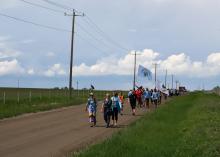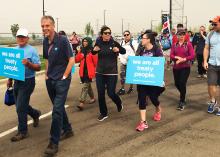Friends and family huddled in light afternoon rain on June 14, waiting for about 30 participants in the Walk for Common Ground to arrive in Calgary. The walkers were led in by a Scottish bagpiper, then greeted with drumming and singing by local Indigenous elders. Tears of joy mixed with the rain as walkers were congratulated for finishing their 14-day journey from Edmonton to Calgary. They walked to honour treaties made between First Nations and the Government of Canada in the 1870s and to start conversations on what the treaty relationship means today.
The Walk for Common Ground was co-organized by Indigenous leaders like Dr. Patricia Makokis, faith groups including Mennonite Church Canada, and the Health Sciences Association of Alberta (HSAA), a province-wide union. Walker and organizer Scott MacDougall, who sits on the social justice committee for the HSAA Board, said churches, unions, and Indigenous peoples are woven together by “a single thread” of shared values like mutual support, but “labels have kept [those groups] from having important conversations” with each other. MacDougall thanked Mennonite participants like Steve Heinrichs, director of Indigenous-settler relations for Mennonite Church Canada, and Allegra Friesen Epp, a practicum student in Heinrichs’s office, for their “gargantuan contribution” to the walk’s organization and success.
Each day, the group walked 20-30 kilometres along Alberta’s secondary highways, in conditions ranging from dry heat to blowing snow. They carried flags symbolizing Treaty 6 (Edmonton and central Alberta) and Treaty 7 (Calgary and southern Alberta), and signs reading “We Are All Treaty People.” At evening stops in churches, colleges, and community centres, walkers were joined by local residents to watch a documentary called “Treaty Talk: Sharing the River of Life,” and then held a sharing circle where participants would reflect on what they had learned with each other that day.
Along the way, Mennonite walkers reflected on how faith shaped their approach to this journey. “I’m participating because I am a Christian,” said Caleb Kowalko, pastor at Calgary First Mennonite Church. “I follow Christ to the margins,” he added, as trucks roared past the walkers on the edge of a two-lane highway.
Cassidy Brown, who grew up near Carstairs, Alta., and now studies at Canadian Mennonite University, said being on the walk challenged and strengthened her faith. “I found myself praying more through this walk,” she said. Brown enjoyed starting each day with a ceremony led by Elder Eugene Makokis from Saddle Lake Cree Nation. The group would pray together “to set our good intentions for the day,” she said, noting she often prayed for strength as the walk was physically and mentally challenging.
Walkers also spoke about the need for settler Canadians to educate each other about treaties. As a pastor, Kowalko hopes to start conversations on how Mennonites can “live in a more loving relationship” with Indigenous peoples in Canada. Treaties, he said, are “agreement[s] of how to share and live side by side” on the same land.
Steve Heinrichs linked the spirit of treaties with sacred agreements from the biblical story, saying “we need to know the covenants of which we’re a part.” He added that for too long, Indigenous peoples have advocated for treaty rights without enough response from settlers.
The Walk for Common Ground was partially inspired by the 2017 Pilgrimage for Indigenous Rights in Ontario, where a group of mostly settlers, including several Mennonites, walked from Kitchener to Ottawa. Both of these walks, said Heinrichs, represented a way for settlers to teach each other about treaties. Allegra Friesen Epp added that as Mennonites, we need to “remember to put [our] faith in action and walk the talk” of standing with communities that society has marginalized.
Indigenous participants in the walk were encouraged to see non-indigenous participants taking an active role in teaching one another. Anita Crowshoe from the Piikani First Nation (Treaty 7) said it was “humbling” to know that churches, including Mennonite Church Canada, were taking on more allied work with Indigenous communities. “I envision settlers creating allies within churches to learn the true intention of the Wampum Belt and Treaty,” she said, referring to an image of two canoes moving side-by-side down a river, sharing space without interfering with each other.
Crowshoe said if someone had told her decades ago that she would be part of a walk like this in her lifetime, she would not have believed them. She spoke with deep emotion when she described the feeling of “being able to walk into Treaty territory with Treaty friends,” both Indigenous and settlers. “It means the world.”
Read about one walker’s experience: My day on the Walk for Common Ground.

Local elders greet walkers at the Health Sciences Association of Alberta office in Calgary as part of the closing ceremony. (Photo by Jonas Cornelsen)

Allegra Friesen Epp carries the eagle feather at the head of the group as they walk along Range Road 11 between Airdrie and Calgary. (Photo by Jonas Cornelsen)

Caleb Kowalko (left) and Steve Heinrichs celebrate reaching their destination in Olds. (Photo by Jonas Cornelsen)

Cassidy Brown (right) and her mother Nola Brown walk along Highway 2A north of Olds, Alta., carrying the Treaty 7 flag. (Photo by Jonas Cornelsen)

Roger Epp of First Mennonite Church Edmonton), left, Kevin Guenther Trautwein of Lendrum MB Church, Werner De Jong of Holyrood Mennonite Church in Edmonton, and Jake Froese of Trinity Mennonite Church in DeWinton join the first leg of the Walk for Common Ground in Edmonton. (Photo by Joanne De Jong)

Undaunted by the poor air-quality index due to the Alberta wildfires, Vic Thiessen, former Mennonite Church Canada staffer, braves the smoke-filled air to join the Walk for Common Ground. The walk began in Edmonton on May 31. (Photo by Joanne De Jong)

Led by Diana Steinhauer and her eagle staff, a group of Indigenous, unionist and church friends travel together on the Walk for Common Ground that began in Edmonton. The treaty walk is meant to nurture treaty understanding and relationship. (Photo by Joanne De Jong)






Add new comment
Canadian Mennonite invites comments and encourages constructive discussion about our content. Actual full names (first and last) are required. Comments are moderated and may be edited. They will not appear online until approved and will be posted during business hours. Some comments may be reproduced in print.